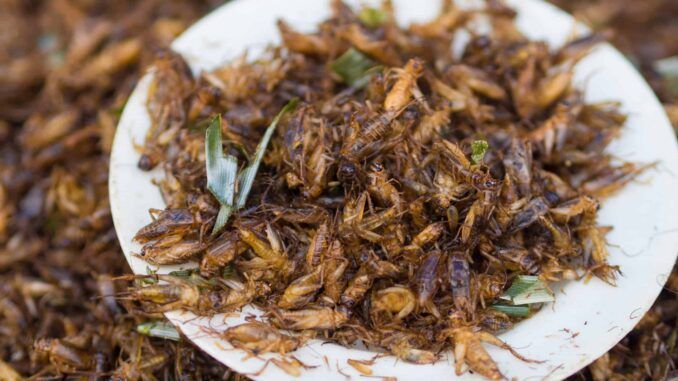
The US Department of Agriculture (USDA) is funding research into trash-derived cricket feed.
The agency has allocated $130,000 in federal funds to support research into cultivating crickets, that have been fed municipal landfill waste, as a source of protein for human consumption
The beneficiary of the USDA’s grant is a company called Mighty Cricket Inc. that specialize in cricket-based food products, according to a report by the Daily Caller.

BYPASS THE CENSORS
Sign up to get unfiltered news delivered straight to your inbox.
You can unsubscribe any time. By subscribing you agree to our Terms of Use
The research started on July 1, 2023, and should be concluded by February 29, 2024.
TGP reports: The agency’s decision to fund research into trash-derived cricket feed is grounded in the belief that it could drastically cut the costs of cricket farming, allowing savings to trickle down to consumers.
The grant listing accuses traditional livestock farming of being overly resource-intensive and environmentally detrimental.
According to the US Spending website:
The research proposed in this application addresses the need for more cost-efficient production of crickets as a sustainable protein source. Compared to conventional proteins, cricket protein retails for over twice the cost. This is even after factoring out water weight (crickets are generally sold dry roasted or powdered).
The two biggest factors driving up the cost include lack of innovation and economies of scale. Unlike the beef, pork, poultry, and soy industries, there has been very little innovation invested into farming crickets. Most of the global production occurs in Thailand, where goods are generally produced via manual labor versus automation. In addition to labor costs, electricity and feed comprise the next two biggest costs in cricket farming.
Utilizing solar energy and insulation helps address electrical costs, meanwhile this research proposal seeks to address feed costs. As innovations reduce the cost of cricket production, it opens the door to more buyers, in turn improving economies of scale.
This research proposal also addresses the need to recapture food waste in the US, diverting a portion of food waste from landfills. The problem of food waste is significant.
According to the USDA, in the United States, food waste is estimated at between 30-40 percent of the food supply. This estimate, based on estimates from USDA’s Economic Research Service of 31 percent food loss at the retail and consumer levels, corresponded to approximately 133 billion pounds and $161 billion worth of food in 2010.
Food is the largest component of municipal landfill waste, accounting for an average of 22%. All of this food waste creates a huge opportunity for Mighty Cricket to procure cricket feed at lower cost than what is available on the market. Mighty Cricket will then be able to pass along the cost savings to buyers of cricket protein. These include consumers purchasing Mighty Cricket products at retail outlets along with manufacturers of pet food, pharmaceuticals, and bioplastics.
In the last 10 years, global demand for alternative proteins has spiked. It is projected to increase at a compound annual growth rate (CAGR) of 18% through 2032, reaching $497.6 billion USD.
The increase in demand is driven by public awareness of the need for more sustainable food sources. Conventional protein production poses a substantial strain on the ecosystem, requiring unsustainable quantities of water, land, and feed as inputs. Furthermore, animal based proteins are also a significant source of greenhouse gas emissions, estimated at 14.5% of all greenhouse gas emissions.
Today’s food system can only feed 3.4 billion people sustainably. To sustain the world’s growing population, food production practices need to dramatically shift towards resource conservation, and consumers are demanding change.
Cricket farming poses one solution to the challenge of food production, as it requires a fraction of consumable inputs compared to conventional proteins. This is why the UN Food and Agriculture Organization recognizes edible insects as a viable alternative to producing food and feed security.
Mighty Cricket will collect data on how the cricket feed produced from waste performs compared to standard feed on the market. The success of the project will be measured on the following objectives: cost savings of the feed, cricket growth, and mortality rates. Ultimately, the company hopes to lower production costs and the environmental footprint of the US food system.
Critics argue that this approach might be too avant-garde, overlooking potential health and ecological concerns associated with rearing insects on landfill waste.
Skeptics argue that without stringent regulations and thorough research into the safety and environmental implications, this initiative could inadvertently introduce toxins into the food chain or exacerbate waste management issues.
Last year the World Economic Forum promoted the EU’s new plan to use mealworms in food in their bid to reduce meat consumption.
The globalists are pushing for the peasants to eat bugs, weeds, and synthetic ‘meat’ because bugs “consume fewer resources than traditional livestock.”


